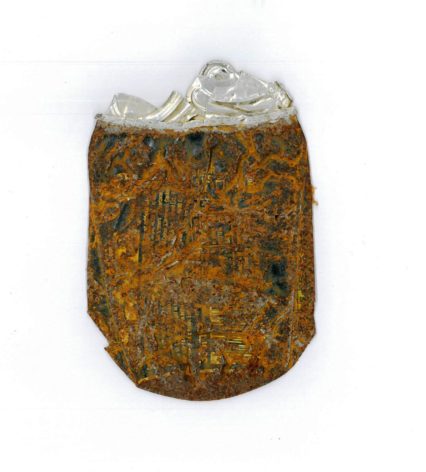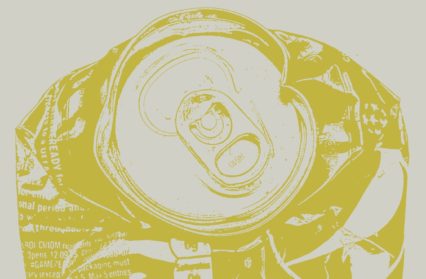Richard Porch discusses the concept that a tin can that has been discarded can be classified as found art in a public space.
We see them mostly dappling the tarmac in car parks. They have been discarded by people too lazy to drop them in litter bins. There they stay until flattened by cars and reduced to being millimetres thin. Then they become metallic litter and are destined to stay stuck to the tarmac until a road sweeper scrapes them up and they are taken away. Otherwise they are destined to form a minute new stratum, a metallic blotch enlivening the blacktop like some random tesserae or a haze of light in an otherwise sea of black. Hopefully they will find their way into the recycling loop and be resurrected as a new can in a matter of months. Their lifespan is allegedly measured in weeks from them leaving the shelf to being used and then discarded and re-entering the manufacturing chain.

I became interested in them as a kind of ‘found art’ when I discovered a really old one that had been squashed flat and rusted. It was also weathered so that its shiny graphic coating had become illegible and converted into a new obscure patina. Plus it was now two rather than three-dimensional and therefore had more in common with a large tin badge than a vessel that had once held a soft drink. More importantly in becoming a flat rusty sliver of metal it had somehow become charged with new possibilities. This change of dimension and finish had invested it (at least in my eyes) with a new creative significance. Freed from being merely a can and therefore functional it was now available (to me) as something decorative. The sculptor Giacometti would have cherished these prematurely aged and withered items for such an aesthetic impact.
Kurt Schwitters would have incorporated them into his Merzbau without a shadow of a doubt had they existed in the 1920/30s. Of course the most likely artist to have picked up and run with idea of tin cans as art would have been Andy Warhol. He’d have photographed them and then screen-printed them in gaudy new colours or made monoprints from the actual cans themselves using them as a kind of stamp or monoprint. The trajectory of their manufactured existence would have served as a perfect metaphor for his ongoing commentary on consumerism. In their newly flattened state adventurous souls in America are (as I write) trying to use them as shingles in walls and tiling for roofs. So, even in their final state of degradation their lifespan is being potentially extended and their use transformed into something practical once again. Ironically the pressure of numerous cars compressing them mimics the colossal grinding forces of nature to create a new kind of urban fossil. It doesn’t matter that in doing so they become a parody of themselves. Once flattened they only look like a representation of a can but one with fresh creative horizons.
One can put them inside a frame and remove it from its setting on the tarmac in the car park and consider it as a piece of found metal artwork. Of course they don’t all weather-down to a nice artistic finish. Some just get squashed, compacted and end up looking like one of George Braque’s Cubist paintings rendered in tin. All the visual cues that enable the onlooker to ‘read’ it as a tin can are still there. It’s just that their perspective has been rearranged into a flat single two-dimensional plane by the act of being crushed by the weight of a car. Throw in for good measure the fact all their graphic branding gets distorted too and you have something intriguingly transformed by the very forces behind its destruction and degradation.
I’m only slightly embarrassed to relate that I’ve started collecting them as I cross urban car parks. Old and new; I collect them all like stamps. The only condition is that they have to be completely flattened so that they are a two-dimensional proposition. Sad I know; but they have such potential.
Richard Porch is a regular contributor at Wales Arts Review.












